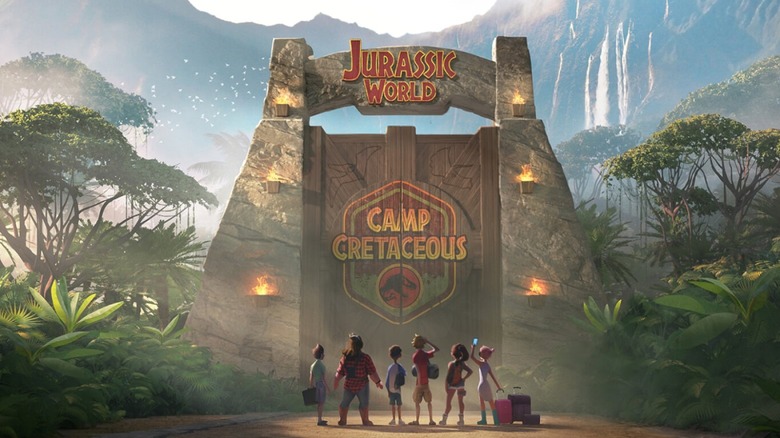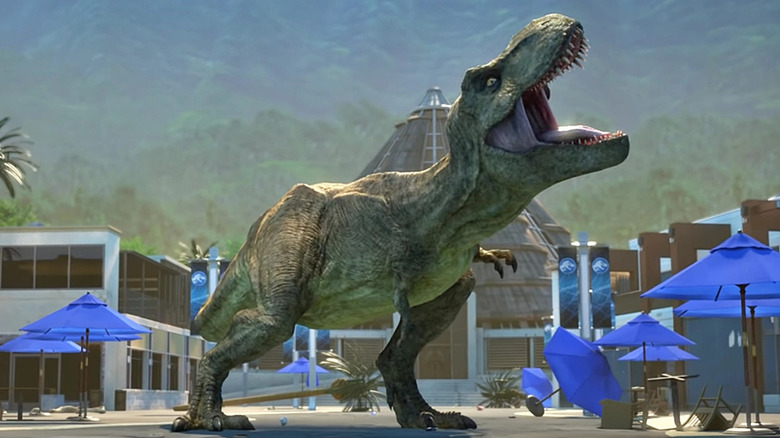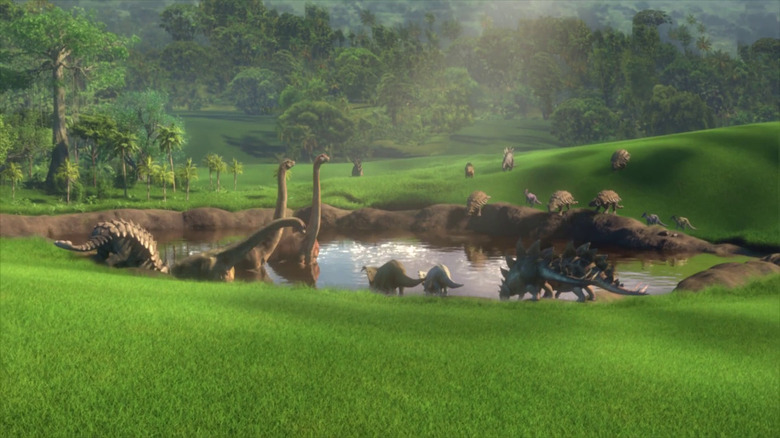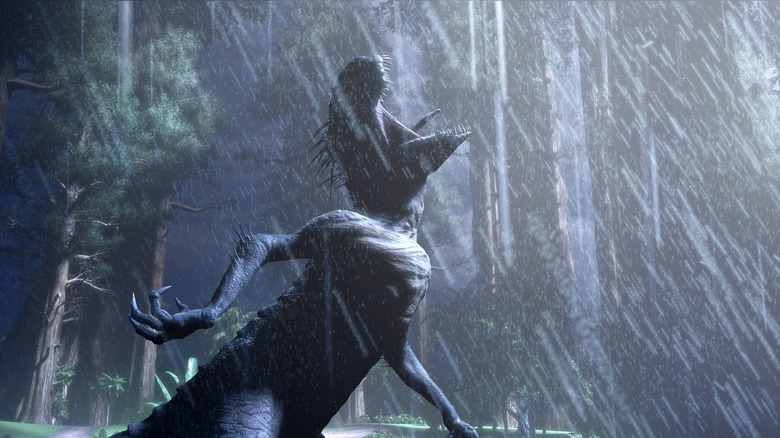Why Camp Cretaceous Is The Best Jurassic Park Sequel
Few franchises have a first movie as great as the first "Jurassic Park," and sequels as bad as the rest of the movies in this franchise. That first movie was such a novel piece of filmmaking, a techno-thriller about the horrors of humans playing god and messing with things we don't quite understand, with a groundbreaking use of animatronics and CGI. Yet the sequels never managed to capture that sense of awe and novelty of the first time we saw a dinosaur. Sure, they have some cool set pieces and memorable moments, but they feel like copies of a copy of a copy.
But there is one "Jurassic Park" sequel that actually manages to capture that same sense of awe, that feeling of terror when the dinos escape, and also the themes of capitalism and greed that the sequels failed to capture. Except it is not a movie that did this, but the animated series "Jurassic World: Camp Cretaceous."
Welcome to Jurassic Park
Set in the days leading up to the events of "Jurassic World," the show follows a group of teenagers attending a summer camp on Isla Nublar. Of course, while they're supposed to have fun, go on a zipline and watch some cute dinosaurs, things went wrong long before the Indominus Rex escaped and destroyed the park.
Indeed, the cartoon makes it clear the park was doomed to fail from the start, with walkie-talkies malfunctioning, GPS devices failing, and emergency breaks and seatbelts just refusing to work. Even the only two camp employees that are meant to keep the children safe and on sight on an island full of killer animals disappear almost as soon as they walk on screen — like they are counselors on Camp Crystal Lake.
Everything that can possibly go wrong in this place goes wrong, just like Michael Crichton intended. You see, while the movie John Hammond would have you believe that he spared no expense on his one-of-a-kind park, the truth, according to the books, is that he cut corners at every chance he got while putting on a front for the public. This is something that even the original movie kind of glossed over, focusing on the technological abuse of the dinosaurs rather than the greed of the park at large. But "Camp Cretaceous" never lets you forget that the problems of the park started not with the want for a dinosaur with more teeth to please shareholders, but with a focus on cutting corners just because they could.
Life finds a way
Let's make something clear, no movie in the franchise has come anywhere near close to replicating the sheer sense of awe of that first scene with the Brachiosaurus in the original "Jurassic Park." They've tried to compensate by introducing new and bigger dinosaurs with every movie, but none of them have had that same "wow factor." Likewise, every sequel has somewhat attempted to draw a line between the dinosaurs being treated as commodities, and zoo animals and poaching, with "Fallen Kingdom" adding animal conservationism to its plot — before it killed almost every dinosaur on Isla Nublar in the cruelest and most sadistic way since Disney pushed dozens of lemmings off a cliff.
"Camp Cretaceous" manages to do both, without the need for excessive animal cruelty. After the kids are abandoned on the island following the destruction of Jurassic World, they get to observe the dinos in their natural habitat. In season 2 this culminates in the discovery of a watering hole where dinosaurs of all kinds, carnivores and herbivores, get together to share water and maybe have a casual conversation. After a season and a half of seeing the horror of dinosaurs as killing machines — with the kids in a constant state of danger — seeing the dinos as more than theme park attractions, but as actual animals, makes for an impactful scene that gets the closest to replicating the sense of wonder of Spielberg's classic.
From season 2 onwards, "Camp Cretaceous" shifted focus away from making dinosaurs the big villains to showing that humans are the true monsters. From big game hunters traveling to the island to kill dinos, to a billionaire that likes to have dinosaurs fight to the death for fun, "Camp Cretaceous" has drawn comparisons between the treatment of de-extinct dinosaurs and real-life animals, with the kid protagonists often putting their own lives and their chances at finally escaping the park in peril in order to save the animals.
Hold onto your butts
And yet, "Camp Cretaceous" also knows when to turn its dino-horror dial way up. Not only is the destruction of Jurassic World more tense in the show than in the film, but season 3 gives us the first legitimately scary dinosaur since the Spinosaurus or the Pteranodons in "Jurassic Park III."
The most surprising part of it is that the "villain" of "Camp Cretaceous" season 3 is a hybrid dinosaur, just like in each one of the new movies — the Scorpios Rex. Meant to be the first hybrid dinosaur designed by Dr. Wu, the Scorpios Rex is a true Frankenstein's monster. With a look that more closely resembles the cursed designs of the abandoned "Jurassic Park 4," this creature looks almost human at times, with opposable thumbs, and longer arms than any other carnivore we've seen in the franchise, capable of moving on two legs or on all fronts. It also has monstrous red eyes, jagged, uneven teeth, and venomous quills it can launch at targets, including one of the kids who almost dies a horrible death.
Everything about the Scorpios Rex, from its almost malformed look to its erratic behavior screams horror movie monster, and the fact that it very nearly kills one of the kids in a kids' show is enough to make this a rare moment post "The Lost World" where the franchise truly felt like a horror movie.
It may not have A-list actors or a huge budget, but "Jurassic World: Camp Cretaceous" has got closer to capturing the spirit of Spielberg's first "Jurassic Park," and Crichton's original novel, than any of the sequels in the franchise.



